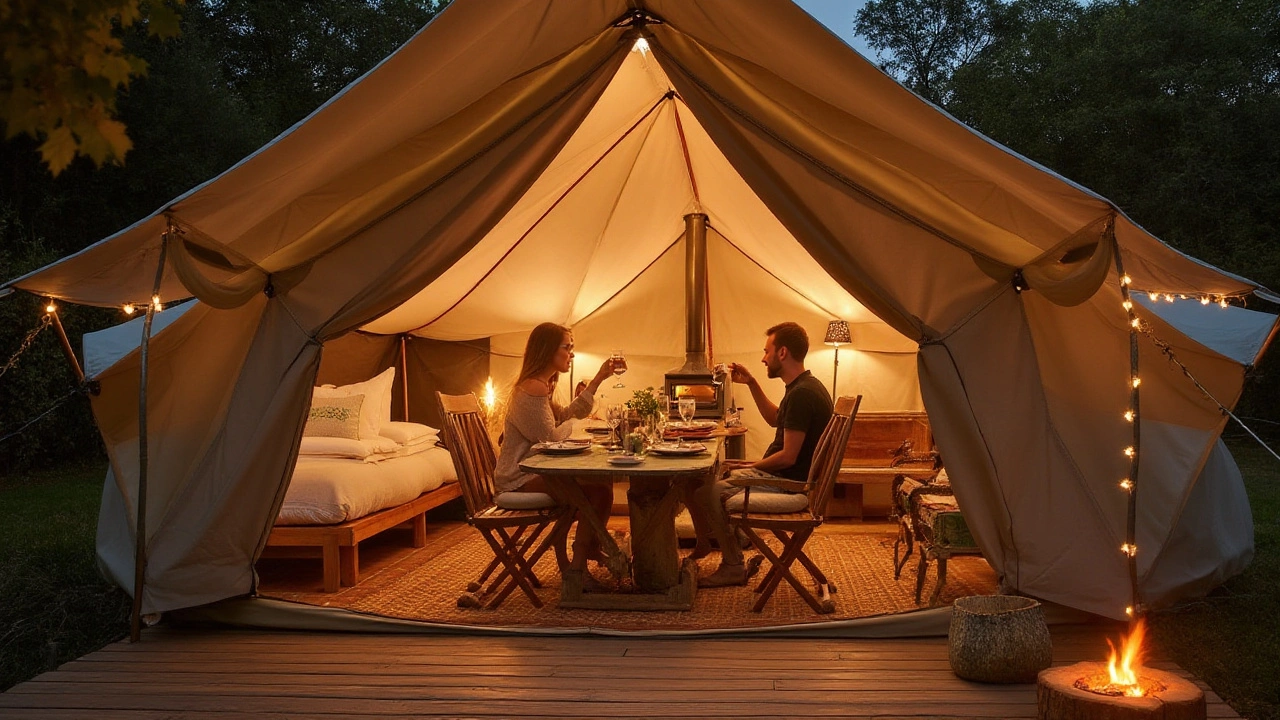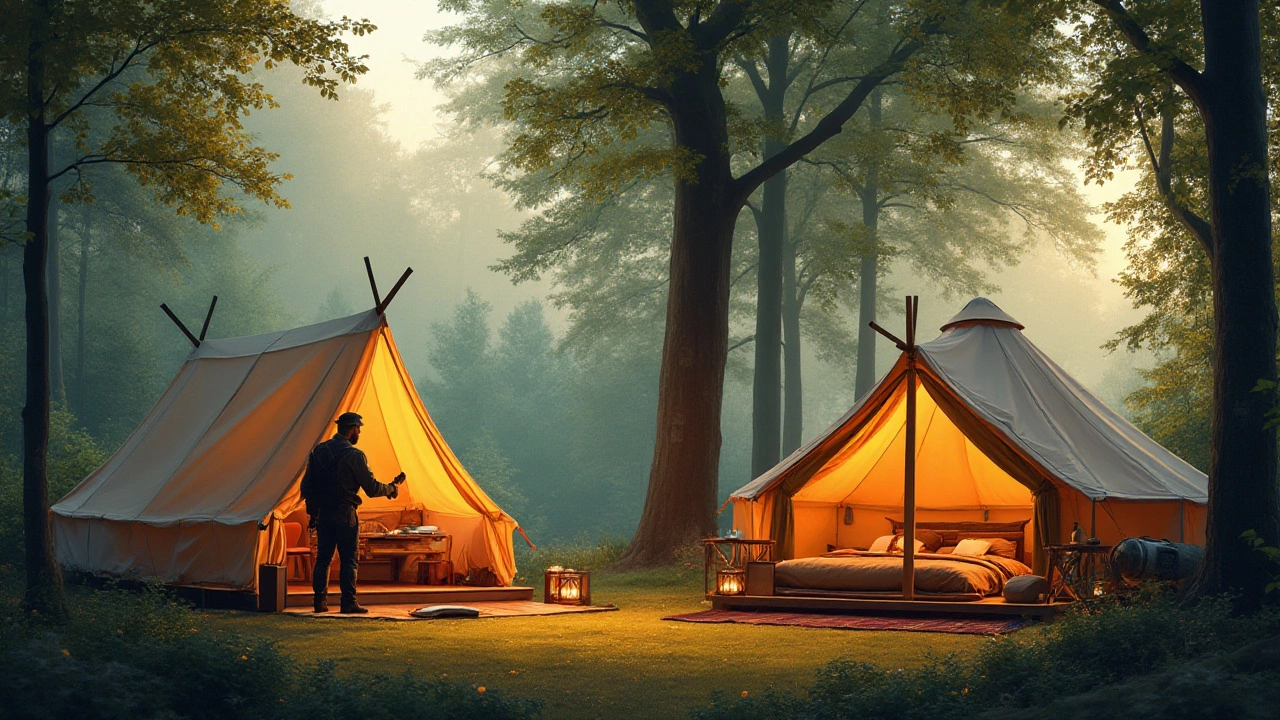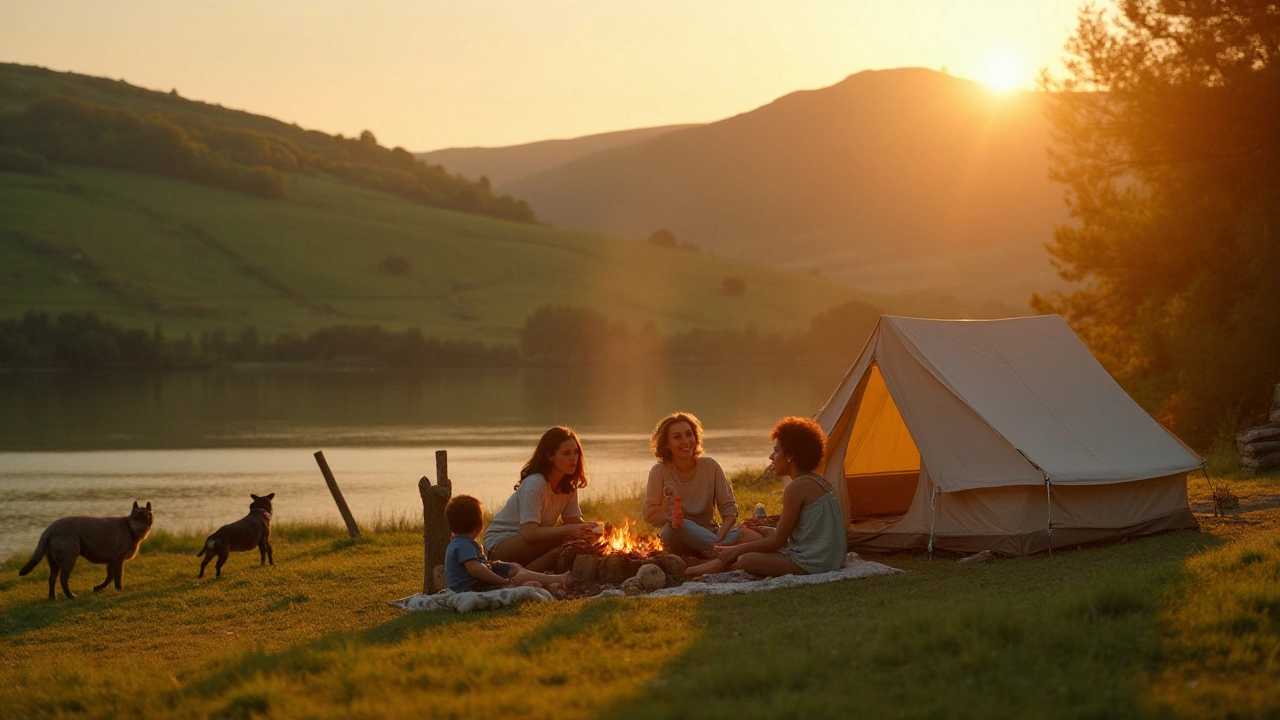Dipping your toes into the world of outdoor retreats opens up a fascinating debate: glamping or traditional camping? Both have their own charm, but the question often boils down to cost. Which one demands deeper pockets, and what does your money really buy you in the great outdoors?
Glamping, a mash-up of 'glamorous' and 'camping', offers a luxurious twist on the classic camping experience with creature comforts like plush bedding and sometimes even electricity. On the flip side, traditional camping strips things down to the bare essentials, often needing nothing more than a tent and a sleeping bag, which usually keeps costs lower.
In this article, we'll dig into the financial side of these adventures, exploring how much you need to invest for a night under the stars. We'll also take a peek at eco-friendly cottages, which might just be the perfect balance if you're looking for a bit of both worlds. Whether you're a budget-conscious explorer or a comfort-seeking traveler, understanding these options will help you plan your ideal getaway effectively.
- Understanding Glamping and Camping
- Comparing Costs: Campsites vs. Glampsites
- Eco-friendly Cottages: A Middle Ground?
- The True Cost of Comfort in Nature
- Tips for Budget-friendly Outdoor Adventures
Understanding Glamping and Camping
When you strip away the layers of modern life, camping represents a return to nature. It's the simple act of pitching a tent, starting a campfire, and sleeping under the stars. The essentials include perhaps a tent, a sleeping bag, a flashlight, and the sheer willingness to set aside convenience for the refreshing breath of the wild. Many campers relish the minimalist approach, prizing the interactions with nature that are only possible when one is truly immersed in it. Traditional camping strategies often stem from a desire for self-sufficiency and an appreciation of the Earth's raw beauty.
On the flip side, glamping—a portmanteau of 'glamorous' and 'camping'—caters to those looking to enjoy the beauty of nature without sacrificing comfort. Picture it: cozy beds, sometimes ensuite bathrooms, heating or air conditioning, and not to forget, Wi-Fi. Glamping sites range from yurts in the middle of a Montana field to treehouses perched in the Scottish Highlands. Its rise in popularity is partly a response to the demands of modern travelers who seek experiences more enriching than typical hotel offerings yet are unwilling to compromise on comfort. According to a report by the International Glamping Business, the glamping market is expected to grow by more than 15% annually—the personalization and flexibility it offers are simply unmatched.
"Glamping bridges the gap between two opposing desires: the call of the wild and the comforts of civilization," notes Lindsey Ramson, an outdoor lifestyle expert.
The financial aspect of glamping versus camping also highlights their distinct nature. Traditional camping is generally low cost, since you need minimal gear and fees, often limited to entrance or camping permits. In contrast, glamping can range significantly, with prices extending into hundreds per night depending on the location and amenities offered. Beyond mere pricing, what you're really investing in with glamping is a unique experience—imagine having heated floors in your tent while outside, a snowy vista stretches beyond your plot.
Not to be overlooked is the rising trend of eco-friendly cottages, which blend the rustic appeal of camping with sustainable living practices. These cottages often use renewable energy sources, water-saving appliances, and recycled materials to reduce the ecological footprint. They stand as testament to a growing demographic unwilling to choose between their lifestyle and environmental responsibility, carving a niche for travelers who desire luxurious nature retreats without the high environmental cost.
Here's a quick look at some differences between camping and glamping:
- Camping Gear: Tent, sleeping bag, cooking equipment, basic provisions.
- Glamping Accommodations: Yurts, pods, tiny houses, treehouses.
- Comfort Level: Bare essentials versus plush interiors.
- Activities: Hiking, fishing, traditional campfire cooking for camping; curated excursions and gourmet dining for glamping.
As we delve further, the choice between camping and glamping isn't merely a monetary one; it's a choice between traditions and luxury, raw nature, and curated wilderness experiences. Understanding these complexities can help tailor your next adventure to meet both your expectations and your budget.
Comparing Costs: Campsites vs. Glampsites
When it comes to exploring the vast outdoors, one of the pivotal considerations is cost. Traditional camping has long been synonymous with affordability, largely due to its simplistic approach. The basic setup includes a tent, sleeping bag, and maybe a few camping chairs. Campsite fees typically range from free in national forests to about $30 per night in popular national parks. Meanwhile, glamping flips this narrative by offering plush amenities like real beds, electricity, and sometimes even en-suite bathrooms. Glampsite prices vary significantly, starting from around $100 and shooting upwards to several hundred dollars per night depending on the level of luxury offered.
The allure of glamping isn't just in the comfy beds or the flushing toilets, but in the unique locations and experiences it often includes. For instance, a glamping site might offer panoramic views of a national park from a handcrafted yurt or a night under the star-studded sky from the deck of a treehouse. Traditional camping sites seldom include such glamorous add-ons, which is precisely what keeps their price accessible for many adventurers. Glampsites often justify their higher costs with these exclusive experiences and added comforts, positioning themselves as a midpoint between traditional camping and staying in a boutique hotel.
Stephen Leahy, an outdoor travel expert, once mentioned that, "A night in nature doesn't mean surrendering comfort, especially when glamping brings the best of both worlds." This blend of nature with luxury creates a unique appeal that resonates with those who may not want to 'rough it' completely. In the quest for comparing these options, it is essential to factor in not just the upfront cost but also the value of comfort and ease. An average camper might spend about $50 on gear initially, while a glamping enthusiast pays for the privilege of having everything ready-to-use upon arrival.
To understand the broader context, let’s consider a summary table for quick comparison between these two experiences:
| Aspect | Campsites | Glampsites |
|---|---|---|
| Nightly Fee | $0-$30 | $100++ |
| Comfort Level | Basic | High |
| Added Amenities | Minimal | Numerous |
| Experience | Traditional | Luxurious |
This comparative approach highlights why some choose the charm of camping while others are swayed by the allure of glamping's lavish offerings. It becomes clear that each choice caters to different preferences and expectations for outdoor adventures. For budget-savvy travelers, sticking to traditional camping fulfills the need to connect with nature without splurging. Conversely, glamping appeals to those who relish comfort, and are willing to pay a premium for it, making their nature getaway more of a retreat than a rustic endurance test.

Eco-friendly Cottages: A Middle Ground?
Amidst the growing popularity of both glamping and traditional camping, eco-friendly cottages are emerging as a captivating middle ground, offering a balance of comfort and environmental consciousness. These structures are often nestled in serene and natural surroundings and provide an authentic retreat experience without sacrificing modern comforts. Unlike the typical luxury found in glamping tents, eco-friendly cottages usually incorporate sustainable materials and technologies to minimize their ecological footprint, which can vary from solar panels to rainwater harvesting systems. This unique blend of eco-consciousness and natural beauty makes them a compelling choice for nature lovers who are also mindful about sustainability. For those who find traditional camping a bit too rustic and glamping perhaps overly extravagant, cottages present a compromise, offering both comfort and a connection to nature without the extremes of either option.
To delve deeper into what makes these eco-friendly cottages an appealing choice, consider not just their ability to provide comfort but also their commitment to reducing environmental impact. Many of these cottages employ energy-efficient designs and materials, creating a space that is harmonious with its environment. For example, some are built using reclaimed wood or feature green roofs that provide natural insulation while minimizing visual impact on the landscape. This thoughtful construction not only benefits the planet but also enhances the guest experience by promoting a closer bond with the natural world. An added advantage is that these cottages often support local economies by using locally sourced materials and labor, ensuring that your stay contributes positively to the surrounding community. As travelers grow more conscious of their carbon footprints, properties that implement these sustainable practices become even more attractive.
It's not just about the environment, either. Eco-friendly cottages often excel in providing unique cultural experiences. Hosts may offer guests the chance to learn about local flora and fauna or participate in community-led initiatives aimed at conservation efforts. Such opportunities transform a simple stay into a more enriching experience, allowing visitors to engage intimately with their surroundings. In turn, this engagement can foster a deeper appreciation for the natural world and highlight the importance of conservation, making eco-friendly cottages a pivotal component of sustainable tourism. According to a study by the Global Sustainable Tourism Council, “Travelers are increasingly seeking holidays that are ethical and reduce environmental impact,” reflecting the high demand for these eco-centric accommodations.
Jane Doe, a leading expert in sustainable tourism, heralds these cottages as, "a crucial step in balancing tourism with ecological responsibility."These insights not only enhance guest experiences but also contribute to their understanding of ecological preservation.
When it comes to pricing, eco-friendly cottages often offer competitive rates when compared to glamping options, particularly in popular tourist regions. Although they can be more expensive than traditional camping, the added cost frequently reflects the sustainable improvements and exceptional comfort provided. To make an informed choice, travelers should consider their priorities—whether it's the cost savings of camping, the luxury of glamping, or the eco-conscious ethos of a cottage stay. A quick glimpse at pricing charts shows that while you might spend a bit more on a night at an eco-friendly cottage, the value in terms of experience, sustainability, and comfort could outweigh the cost for those environmentally inclined.
Eco-friendly cottages illustrate a responsible travel trend that aligns with growing environmental concerns. They're an option that soothes the need for comfort while respecting the delicate ecosystems of their surroundings. So when planning your next outing, consider whether these lodges might just offer you the perfect getaway—a blend of nature, comfort, and mindfulness about your impact. This beautiful balance between modern amenities and ecological mindfulness makes them an exciting option for people who want to enjoy nature without the guilt of leaving a heavy footprint, providing a wonderful middle ground between traditional camping and luxurious glamping.
The True Cost of Comfort in Nature
When venturing into the realm of glamping, the allure lies in its promise of comfort and convenience, often translating into significant expenses compared to traditional camping. This experience often comes equipped with amenities such as temperature-controlled tents or yurts, plush bedding, and sometimes even en-suite bathrooms. While these luxuries enhance the experience, they inevitably inflate the cost. For instance, glamping sites can range from $150 to $3,000 per night, depending on the location and level of opulence offered. These prices reflect the various services provided, such as gourmet meals, guided tours, and other personalized experiences. In contrast, a simple campfire meal might be all a traditional camper needs, costing just a fraction of a fancy glamp-dinner.
Interestingly, the rise in popularity of eco-friendly cottages as a middle ground presents an intriguing option. These accommodations offer a blend of nature immersion with sustainability-focused amenities. They allow eco-conscious travelers to enjoy increased comfort while being mindful of their carbon footprint. Many eco-friendly lodges use renewable energy sources or reclaimed materials in their construction, striking a balance between luxury and environmental responsibility. A study by the "Eco Tourism Society" noted that about 70% of eco-friendly lodging guests reported a high level of satisfaction with their balance of nature experience and amenities.
Despite the higher price, many glamping enthusiasts argue that the value of comfort and a worry-free setup outweighs the cost difference. The convenience of arriving at a site where shelter and entertainment are pre-arranged can make a vacation feel more like a true escape. Considerations such as these bring into focus not only a person's willingness to pay more but their lifestyle preferences as well. A quote by the tourism expert Jonathan Tourtellot captures this essence:
"The expense of glamping can be seen as paying for peace of mind and that indulgent connection to nature without the harsher realities of traditional camping."Such perspectives emphasize the subjective nature of how one values comfort versus cost.
Additionally, some glamping sites provide unique and unforgettable settings that traditional camping may not readily offer. For instance, staying in a bubble tent under the expansive night sky in a remote desert or overlooking a cliff with a breathtaking ocean view. These experiences, often facilitated by the premium paid, offer stunning returns in memories and tranquility that a typical tent might not. It's not unusual for these trips to include activities like spa services, cooking classes, or wine tastings, which all contribute to the higher expenditure yet create a nuanced experience that many find difficult to replicate outside the glamping realm.
Even so, deciding whether to go for a glamping experience or embrace the traditional camping route ultimately depends on what one seeks from their time in nature. For some, it is the simplicity and raw beauty of the wilderness that hold the most value; for others, it's the ability to relive those serene scenes with all the comforts of a modern hotel. As the outdoor experience landscape continues to evolve, it seems apparent that both glamping and eco-friendly cottages will find their appreciative audiences, each willing to weigh the cost of comfort in their own unique way.

Tips for Budget-friendly Outdoor Adventures
Dreaming of a serene escape into nature without breaking the bank? Whether you're a die-hard fan of traditional camping or tempted by the allure of glamping, saving money while enjoying the great outdoors is entirely possible with a few smart strategies. Start by planning well in advance. Booking campsites early can often secure lower rates, especially in high-demand parks or private lands. Seasonal fluctuations play a big role, so consider traveling during shoulder seasons when prices drop and crowds thin. It not only saves money but also promises a more tranquil experience.
Another crucial tip lies in embracing minimalism with your gear. While fancy equipment might catch your eye, remember that you can have an authentic experience with just the basics. Borrowing or renting gear is a fantastic way to cut costs. Many outdoor enthusiasts swap sleeping bags and tents among friends, or even rent from local outdoor stores for a fraction of the purchase price. When it comes to food, preparing your own meals is both cost-effective and rewarding. Whip up hearty, simple dishes like pasta or chili that can be made in bulk over a campfire. Packing non-perishables or meals you prepped at home will also help avoid pricey dining options. One voyageer's tip: “Investing time in planning meals ahead and packing efficiently allowed us to indulge more in activities we love, rather than stressing over last-minute food runs,” as noted in an interview with the outdoor blogger Kate Jacobs.
Transportation costs can sneak up fast, so try carpooling with friends or using public transportation to your campsite when feasible. Reducing the number of cars not only cuts travel costs but also lessens the environmental impact, aligning perfectly with the spirit of eco-friendly travel. If you're adventurous, putting together an itinerary that combines hiking and public transport could open up new and unexpected destinations. For those eyeing glamping experiences, search for deals on platforms offering last-minute discounts on luxury stays or opt for stays that are slightly off the beaten path, where prices are often more competitive. Sharing your accommodations with friends or family can divide the costs significantly while adding to the fun.
To illustrate the potential savings, here's a small breakdown of expenses comparing costs for a weekend camping trip versus a glamping getaway for a group of four:
| Expense | Camping ($) | Glamping ($) |
|---|---|---|
| Site Booking | 40 | 200 |
| Equipment Rental | 100 | 80 |
| Food | 60 | 120 |
| Transport | 70 | 70 |
| Total | 270 | 470 |
Finally, keep an open mind about where you're staying. Look into free campsites or dispersed camping on public lands where fees are non-existent. Websites and apps like FreeRoam and Campendium provide valuable information about these sites, helping you explore nature without cost restraints. By combining these tips, your quest for a budget-friendly outdoor adventure, whether it's traditional camping or a touch of glamorous camping, becomes not only rewarding but financially sensible. Enjoy the open trails, starry skies, and the contentment that comes from knowing you’ve smartly managed your outdoor escape.

